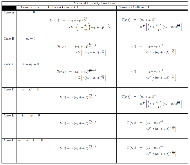Conditions for translation and scaling invariance of the neutron diffusion equation
- Los Alamos National Lab. (LANL), Los Alamos, NM (United States); Arizona State Univ., Tempe, AZ (United States)
- Los Alamos National Lab. (LANL), Los Alamos, NM (United States)
Lie group methods are applied to the time-dependent, monoenergetic neutron diffusion equation in materials with spatial and time dependence. To accomplish this objective, the underlying 2nd order partial differential equation (PDE) is recast as an exterior differential system so as to leverage the isovector symmetry analysis approach. Some of the advantages of this method as compared to traditional symmetry analysis approaches are revealed through its use in the context of a 2nd order PDE. In this context, various material properties appearing in the mathematical model (e.g., a diffusion coefficient and macroscopic cross section data) are left as arbitrary functions of space and time. The symmetry analysis that follows is restricted to a search for translation and scaling symmetries; consequently the Lie derivative yields specific material conditions that must be satisfied in order to maintain the presence of these important similarity transformations. The principal outcome of this work is thus the determination of analytic material property functions that enable the presence of various translation and scaling symmetries within the time-dependent, monoenergetic neutron diffusion equation. The results of this exercise encapsulate and generalize many existing results already appearing in the literature. While the results contained in this work are primarily useful as phenomenological guides pertaining to the symmetry behavior of the neutron diffusion equation under certain assumptions, they may eventually be useful in the construction of exact solutions to the underlying mathematical model. Furthermore, the results of this work are also useful as a starting point or framework for future symmetry analysis studies pertaining to the neutron transport equation and its many surrogates.
- Research Organization:
- Los Alamos National Laboratory (LANL), Los Alamos, NM (United States)
- Sponsoring Organization:
- USDOE
- Grant/Contract Number:
- AC52-06NA25396
- OSTI ID:
- 1480041
- Alternate ID(s):
- OSTI ID: 1636161
- Report Number(s):
- LA-UR-18-20828
- Journal Information:
- Progress in Nuclear Energy, Vol. 110, Issue C; ISSN 0149-1970
- Publisher:
- ElsevierCopyright Statement
- Country of Publication:
- United States
- Language:
- English
Web of Science
Scaling in Cavity—Expansion Equations using the Isovector Method
|
journal | September 2017 |
Geometric Approach to Invariance Groups and Solution of Partial Differential Systems
|
journal | April 1971 |
Group classification of the equations of two-dimensional motions of a gas
|
journal | January 1994 |
Symmetry and separability of the neutron diffusion equation
|
journal | October 2018 |
Solutions of the Noh problem for various equations of state using LIE groups
|
journal | January 2000 |
Similar Records
The infinite medium Green's function for neutron transport in plane geometry 40 years later
Symmetries of the Gas Dynamics Equations using the Differential Form Method
